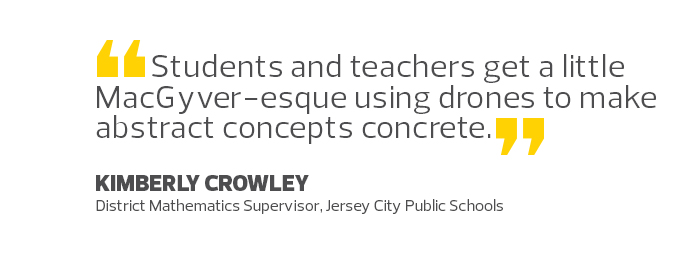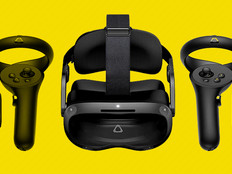With Drones, Students Tackle Complex Topics
Three years ago, an innovative educator in Jersey City Public Schools’ Division B introduced drones to a class of elementary students with autism. Her goal was to enhance student engagement, and the results from that experiment were encouraging.
“Students stayed on task better and were more involved with learning,” says project leader Kimberly Crowley, a mathematics supervisor for the New Jersey district.
Crowley is now known as “Drone Girl” to many students. Thanks to the success of that experiment, drones have taken off throughout the district. Today, more than 100 teachers are using them in their classrooms, and about 3,000 students have participated in what’s become the Division B Drone Project.
Jersey City Public Schools’ drone experience isn’t unique. Educators at Avonworth School District, near Pittsburgh, are seeing similar results.
“Students become heavily engaged in projects that use drones,” says Michael Lincoln, who teaches computer programing and media design at Avonworth.
Lincoln’s middle school students are honing programming skills by writing flight-control software.
Some have even created a fanciful YouTube children’s show that features the Mayor of Drone City, who dreads public speaking. Written for kindergarten students, the stories teach lessons about overcoming fear and believing in yourself.

Projects like these are heightening drone awareness among K–12 educators across the country. The latest Horizon Report for K–12 lists drones among a handful of consumer technologies that weren’t originally designed for education but “may serve well as learning aids and be quite adaptable for use in schools.”
But drone adoption faces pushback. Teachers may resist adding one more initiative to an already-full day. Administrators and budget managers may view drones in the classroom as not worthy of investment when funds are limited. Drone advocates counter that, when backed by solid implementation plans, the time and money spent on a drone project can deliver concrete benefits, primarily in the form of highly engaged students.
Drones in Education Create Unconventional Experiences
Crowley’s drone journey began with a fundamental question.
“I asked myself, ‘What new and fun thing can we do to support education?’ ” she says. “That gave me the idea to use drones in everyday lessons. People thought it was a crazy idea, but with the backing of my boss, we decided to try it and see if it would work.”
After the initial project’s success, Crowley attracted 22 teachers who volunteered to brainstorm ideas for math classes. That spawned skip-counting lessons for kindergarteners, who watch drones make a series of landings on numbers placed on the classroom floor. Intermediate grades use a more advanced version of the lesson to visualize fractions. Eighth-grade teachers attach chalk to a drone to outline its flight path across a floor to help pupils imagine and solve quadratic equations.
“Students and teachers get a little MacGyver-esque using drones to make abstract concepts concrete,” Crowley says.
Jersey City Public Schools use large Parrot AR drones, which have a Styrofoam shell for durability. That makes them good models to start with as teachers learn to avoid crash landings, Crowley says. Recently, the district added Parrot’s smaller Bebop units. Both models come with built-in video cameras, allowing students to create videos that they can download to their Chromebooks. Users control the machines via smartphone apps or with optional remote-control hardware.
Avonworth School District relies on Parrot AR and Minidrone models, as well as machines from DJI, which produces the Phantom, Spark, Mavic and Matrice. Students write their flight-control software using Scratch and Scratch Junior, free programming languages from the Lifelong Kindergarten Group at the MIT Media Lab.

Students run their Scratch code using Chromebooks or traditional laptops, which enable them to maneuver drones around obstacles without a conventional remote controller. “It’s important for students to create programs for physical objects that are actually in their world, not just for objects on a computer screen,” Lincoln says.
Another project uses flybys to monitor construction at the high school. The DroneDeploy app lets students capture various measurements to analyze progress and the remaining volume of raw material at the site.
“This shows how technology can be used to gather data for making better decisions,” Lincoln says.
Emerging Tech Promotes Adaptability
Crowley and Lincoln have bought into the drone concept, but what about educators who dismiss the technology as just a fad? Lincoln isn’t making predictions about the future of drones in education, but he says it’s not necessarily bad if they are a short-lived phenomenon.
“Our world keeps changing rapidly, and students should learn to look for the next thing that will be coming along,” he says. “Adaptability to change is a skill that students will need in their personal and professional lives.”









